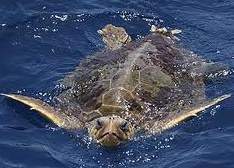 Sea turtles likely have been nesting on Oak Island for as long as the island has existed. Matthew Godfrey, Ph.D., a biologist for the North Carolina Wildlife Resources Commission, says the main species nesting on Oak Island is the Loggerhead, with some occasional Green turtles. “We have records of nests of Loggerheads on Oak Island going back to 1984,” Godfrey says. “But, there are earlier records of Loggerheads in Carolina going all the way back to Mark Catesby, who reported them in 1743.”
Sea turtles likely have been nesting on Oak Island for as long as the island has existed. Matthew Godfrey, Ph.D., a biologist for the North Carolina Wildlife Resources Commission, says the main species nesting on Oak Island is the Loggerhead, with some occasional Green turtles. “We have records of nests of Loggerheads on Oak Island going back to 1984,” Godfrey says. “But, there are earlier records of Loggerheads in Carolina going all the way back to Mark Catesby, who reported them in 1743.”
Every year from May through August, late at night while most homeowners of Oak Island Realstate in North Carolina, are fast asleep, an amazing phenomenon occurs. Loggerhead turtles emerge from the ocean and drag themselves across the sand, leaving behind them what looks to be an oversized tire track. They search for the ideal spot between the dunes and the high-tide line, where they will dig a hole with their back flipper and lay their eggs a foot and a half deep. After covering their eggs with sand, they gradually make their way back to the ocean without a second look back.
The beach is closely monitored during the nesting months. Kellie Beeson, director of the Oak Island Parks and Recreation Department and part of the Oak Island Sea Turtle Protection Program, scans the beach daily looking for the inimitable turtle tracks and depressions in the sand. She marks off the nests with four stakes, yellow tape and a sign marked with the date — otherwise, you wouldn’t know the nests were there. Beeson then coordinates with volunteers to assist with the hatching process.
Overall, the incubation period is between 55 and 85 days. “We begin to monitor the nests on the 50th day, as average hatching is around 62 days this season,” Beeson says. Nesting typically ends mid-August, although eggs may continue to incubate into November.
It’s critical for the nests to be watched closely so the new hatchlings can get back to the ocean without falling prey to seagulls or ghost crabs. How many of the hatchlings survive is highly dependent upon the concentrated efforts of the Protection Program and its volunteers, as well as the residents. “We have hundreds of folks that assist but are either visitors to the island or are not able to make the 100 percent commitment required to be a nest parent,” Beeson says. “The number of folks that are unofficially involved with our program in any one season easily exceeds one thousand.”
When a nest hatches, volunteers are on hand with flashlights to help direct the baby turtles to the ocean. Since the turtles’ natural instinct is to follow the light reflected from the surface of the sea, which may not always be prevalent, the flashlight assistance is critical for them so they don’t go toward an artificial light opposite of the ocean. Once they make their way across the beach, they immerse themselves into the ocean to begin their life journeys.
The female hatchlings that survive to adulthood, after making their way through life in various parts of the ocean, will travel back some thousands of miles to return to where they were born, in this case Oak Island, to nest their future brood.
Contact one of our Sloane Realty sales professionals for information on Oak Island Real Estate.